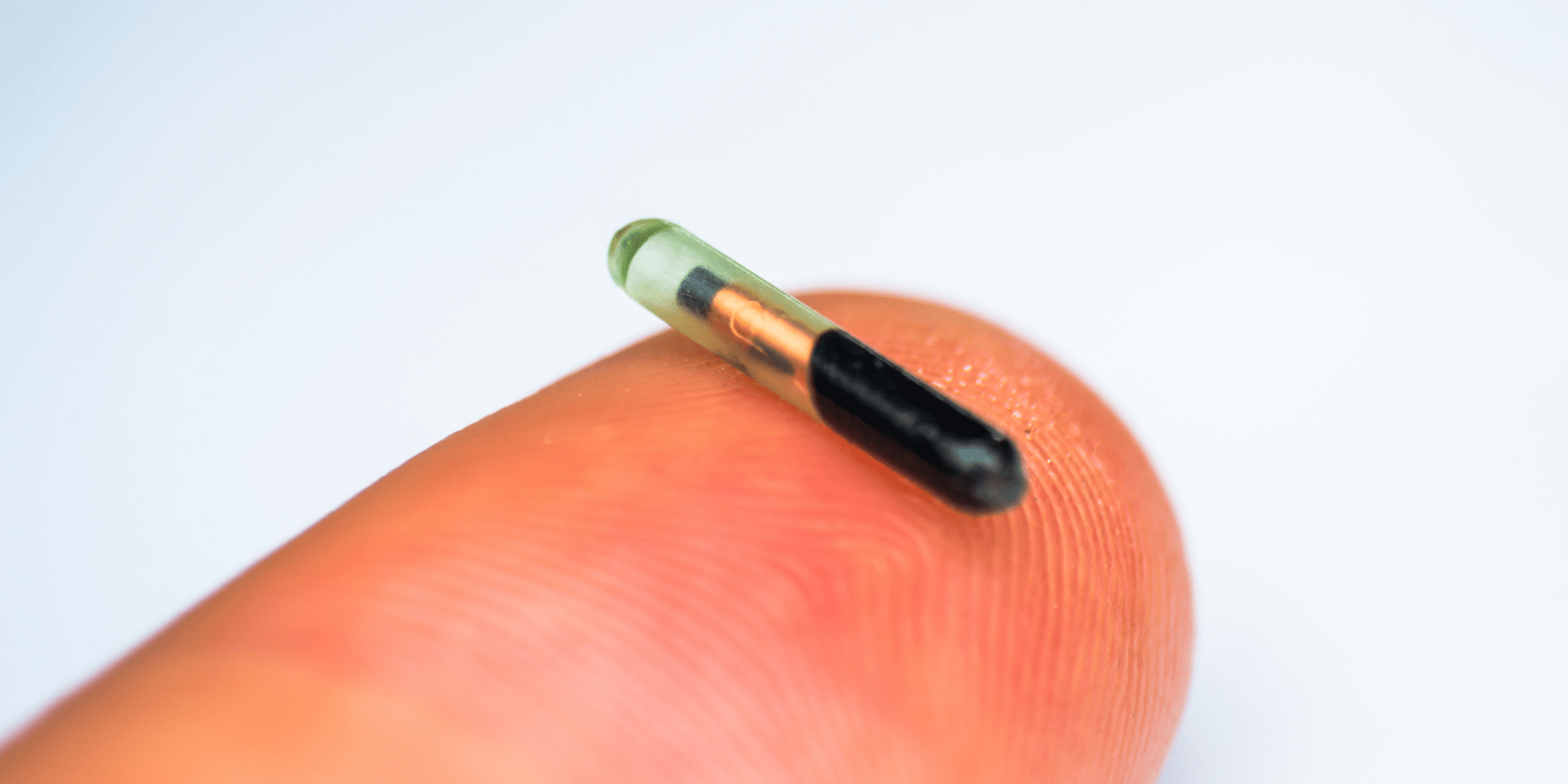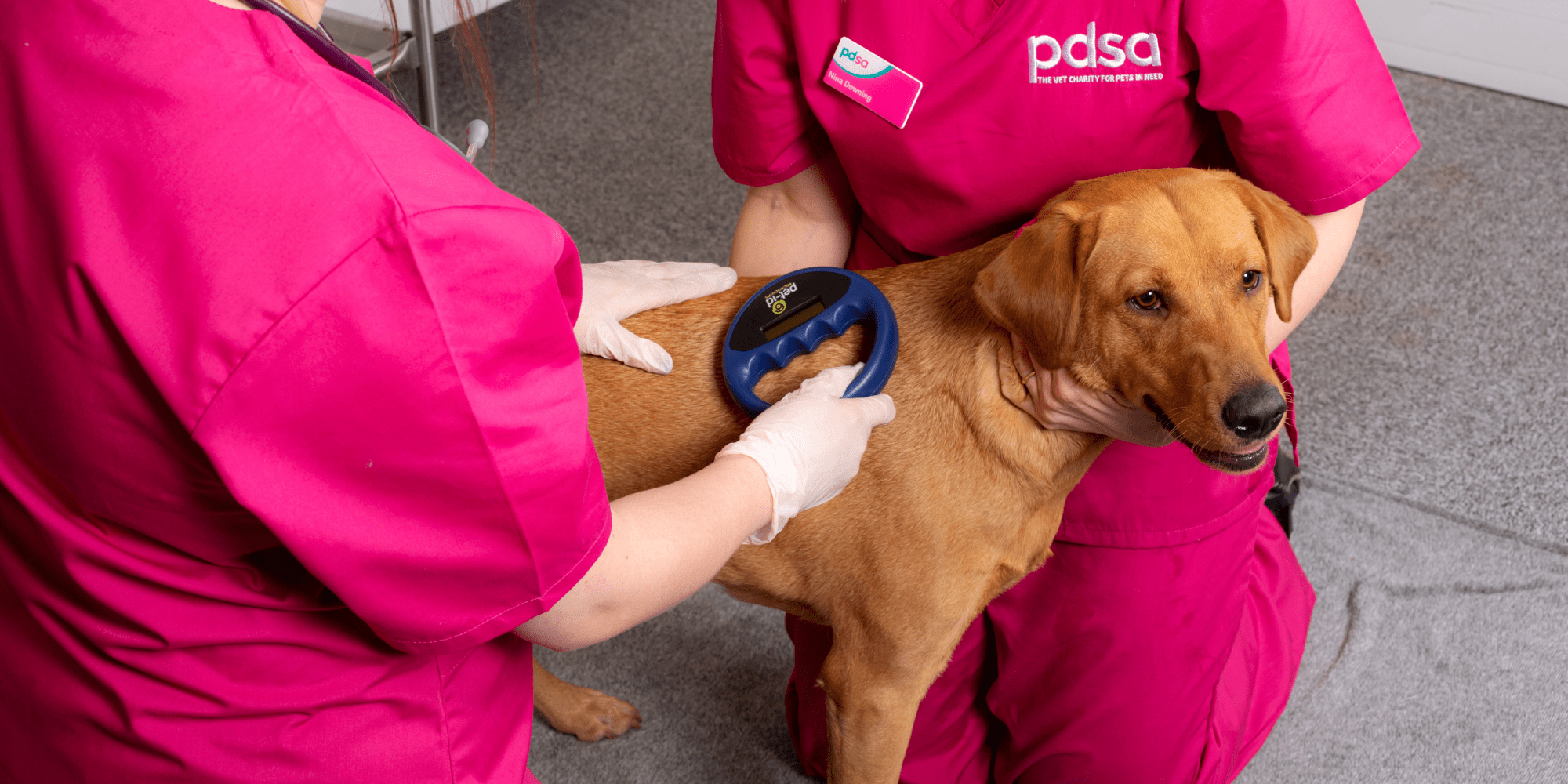Microchipping Your Dog
Overview
- A microchip is a tiny identification device that contains a unique number linking a pet to their owner.
- They help to reunite lost, stolen and injured pets with their owners as quickly as possible.
- It’s a legal requirement for all dogs over eight weeks old to be microchipped unless a vet issues an exemption because of their size or health.
- Microchips are implanted under the skin between the shoulder blades – it’s a very quick procedure that takes just a few seconds.

A microchip is a tiny identification device (the size of a grain of rice) that contains a unique number, which can be read by a scanner. If your dog is microchipped and becomes lost, anyone with a scanner (vets, dog wardens, and rescue centres) can scan them to get their chip number, call the microchip company and (if your contact details are up to date), get you reunited.
Microchips are not linked to GPS and do not allow you to track your dog’s location.
Dog microchipping laws UK
- It is a legal requirement for all dogs over the age of eight weeks to be microchipped in England, Wales and Scotland. However, very small puppies, or dogs with certain health problems, can be issued a temporary exemption certificate from a vet to allow them to be microchipped when they are slightly older.
- If you breed a dog (even if it was unintentional), it’s your responsibility to have all the puppies microchipped by the time they are eight weeks old and to register yourself as their first owner.
- If your dog is scanned by a dog warden and found not to have a microchip, you’ll have 21 days to get them microchipped. If you don’t, you could face a fine of up to £500.
- It’s your responsibility to keep your dog’s microchip details up to date and make sure they are stored on a UK government-approved database.
- As well as a microchip, your dog must also wear a collar and tag (with your contact details on) in public.
- In Northern Ireland, pet dogs must be microchipped before eight weeks of age as part of the dog licence, and must wear a collar and identification tag (with your contact details on) in public.
- Microchips can only be implanted by vets, veterinary nurses, and people who have been specially trained.
- Most owners get their dog microchipped at the vet’s, but if you go elsewhere (such as a rescue centre or grooming parlour), it’s important to make sure the person chipping your pet is qualified to do so.
- The professional who microchips your pet will register them by passing your details on to your microchip database company. They will need your name, address, phone number, pet’s details, and ideally an emergency contact.
- You should then receive your pet’s microchip registration information in the post/by email. If you haven’t received anything within a few weeks then contact the professional who microchipped your pet.
Which database is my dog’s chip registered to?
- There are many different microchip database companies in the UK, so it’s really important that you make sure your pet is registered with one that’s UK government approved.
- Use 'Check a Chip' to check which microchip database your pet is registered with.
How much does it cost to microchip a dog?
- Microchipping usually costs between £10-30. Some vets include a microchip in their health plans, and some charities offer them for a reduced cost or for free.
- Some microchip database companies also offer an enhanced service for a small fee, which often includes unlimited personal detail changes, and assistance if your dog gets lost or stolen.

Changing ownership of a microchipped dog
- If you have just brought a new puppy home, by law, they should already be microchipped and registered with the breeder (unless they have an exemption certificate). When you collect your puppy, the breeder should give you a form/special code that enables you to update their details with their microchip database company.
- If you rehome or sell a pet, you need to contact their microchip database company to let them know. They will give you a form or code to pass on to your pet’s new owner enabling them to change the details linked to the microchip. This process is designed to prevent people from changing a pet’s microchip details without the owner’s permission (i.e. if they were stolen).
Other pets
- It’s not yet a legal requirement for cats to be microchipped however, as of 10th June 2024, it will become law for all cat owners in England to have their cat microchipped by 20 weeks of age. For more information, have a look at our article 'Microchipping your cat'.
- Although it’s not a legal requirement to have any other pets microchipped, we recommend you do. Rabbits, guinea pigs, ferrets, tortoises, and other small pets are notorious escape artists, so having them microchipped will help reunite you quickly if they go wandering.
- Even unusual pets like reptiles and birds can be microchipped – in fact it’s a requirement for some exotic species that fall under the Convention on International Trade in Endangered Species (CITES) rules.
- How do I change my microchip details?
- Does microchipping hurt?
- How long do microchips last?
- What happens to a microchip when a dog dies?
- Can you feel a microchip in a dog?
- How to scan a dog microchip with a phone
How do I change my microchip details?
Contact your microchip company directly - there may be a fee for this. Sometimes you can pay a one-off fee that allows you to make unlimited detail changes for your dog’s lifetime.
Does microchipping hurt?
Your pet’s microchip will be implanted under their skin between their shoulder blades using a needle. Like any injection, microchipping can cause a tiny amount of discomfort but, fortunately, it’s a very quick procedure that takes just a few seconds. Most pets barely notice being microchipped, and a tasty treat afterwards is likely to distract them if they do become upset.
Microchips are made out of non-reactive materials, so once it’s in place it shouldn’t hurt or cause your pet any problems throughout their life.
How long do microchips last?
Microchips are hardwearing and should last for your pet's lifetime. It’s incredibly unusual for them to break or become faulty. In the very rare case that one fails (meaning it can’t be read by a scanner anymore), the chip manufacturer will usually provide a replacement chip free of charge. There is no need to remove the old faulty chip - your vet can simply place the new chip in alongside it.
Much more commonly, microchips move a small distance away from where they are implanted but this doesn’t hurt. It very rarely causes problems and the chip will still be picked up if it’s scanned.
What happens to a microchip when a dog dies?
Once a dog passes away their microchip will remain under their skin, there is no need to remove it.
Can you feel a microchip in a dog?
It is sometimes possible to feel microchips under the skin depending how deep they sit. Microchips sat right under the surface of the skin are much easier to feel than those sitting deeper under another layer of tissue.
How to scan a dog microchip with a phone
It’s not possible to scan microchips with a phone, but it is possible to buy a microchip scanner that you can link to your phone.
Published: August 2023
Did you find this page useful?
Tell us more
Please note, our vets and nurses are unable to respond to questions via this form. If you are concerned about your pet’s health, please contact your vet directly.
Thank you for your feedback
Want to hear more about PDSA and get pet care tips from our vet experts?
Sign up to our e-newsletter
Written by vets and vet nurses. This advice is for UK pets only. Illustrations by Samantha Elmhurst.
